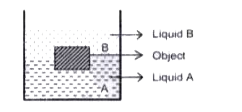The relative densities of four liquids P,Q,R and S are 1.26,1.0,0.84 and 13.6 respectively an object is floated in all these liquids one by one in which liquid the object will float with its maximum volume submerged under the liquid?
P
Q
R
S
The correct Answer is:C
To determine in which liquid the object will float with its maximum volume submerged, we need to analyze the relative densities of the liquids and understand how buoyant force works.
1. Understanding Relative Density:
Relative density (or specific gravity) is the ratio of the density of a substance to the density of a reference substance (usually water). It indicates how heavy a substance is compared to water.
2. Given Relative Densities:
- Liquid P: 1.26
- Liquid Q: 1.0
- Liquid R: 0.84
- Liquid S: 13.6
3. Buoyant Force Concept:
The buoyant force acting on an object submerged in a fluid is equal to the weight of the fluid displaced by the object. The greater the density of the liquid, the greater the buoyant force.
4. Determining Maximum Submersion:
An object will float with the maximum volume submerged in the liquid with the lowest relative density. This is because a lower relative density means a lower buoyant force acting on the object, allowing it to displace more liquid and thus submerge more.
5. Comparing Relative Densities:
- The lowest relative density among the liquids is that of liquid R (0.84).
- The other liquids have higher relative densities: P (1.26), Q (1.0), and S (13.6).
6. Conclusion:
Since liquid R has the lowest relative density, the object will float with its maximum volume submerged in liquid R.
Final Answer:
The object will float with its maximum volume submerged in liquid R (relative density 0.84).
---
Relative density (or specific gravity) is the ratio of the density of a substance to the density of a reference substance (usually water). It indicates how heavy a substance is compared to water.
- Liquid P: 1.26
- Liquid Q: 1.0
- Liquid R: 0.84
- Liquid S: 13.6
The buoyant force acting on an object submerged in a fluid is equal to the weight of the fluid displaced by the object. The greater the density of the liquid, the greater the buoyant force.
An object will float with the maximum volume submerged in the liquid with the lowest relative density. This is because a lower relative density means a lower buoyant force acting on the object, allowing it to displace more liquid and thus submerge more.
- The lowest relative density among the liquids is that of liquid R (0.84).
- The other liquids have higher relative densities: P (1.26), Q (1.0), and S (13.6).
Since liquid R has the lowest relative density, the object will float with its maximum volume submerged in liquid R.
The object will float with its maximum volume submerged in liquid R (relative density 0.84).
Similar Questions
An object of mass m is floating in a liquid of density σ. If the object is made up of density ρ, then appare weight of the object in the liquid is
View SolutionA beaker contains a liquid of volume V0. A solid block of volume V floats in the liquid with 90% of its volume submerged in the liquid. The whole system is heated to raise its temperature by Δθ. It is observed that the height of liquid in the beaker does not change and the solid in now floating with its entire volume submerged. Calculate Δθ. It is given that coefficient of volume expansion of the solid and the glass (beaker) are γs and γg respectively.

View Solution
Knowledge Check
The relative densities of four liquids P,Q,R and S are 1.26,1.0,0.84, and 13.6 respectively .An object is floated in all these liquids ,one by one .In which liquid will is maximum volume submerged under the liquid ?
APBQCRDSA block of density ρ floats in a liquid with its one third volume immersed. The density of the liquid is
AρBρ3Cρ2D3ρWhen a body of density d1 and volume V is floating in a liquid of density d2
Aits true weight is Vd2gBloss in its weight is Vd2gCits apparent weight is zeroDits density d1 is greater than that of liquid d2 .
An object is made to float in two immiscible liquids as shown in figure. Compare the densities of two liquids A and B and the object.

View SolutionWrite an expression for the relative density of a solid floating in a liquid in terms of the volume of the solid in the liquid and the total volume of the solid.
View SolutionA container is filled with two immiscible liquids A and B of densities 2 g cm−3and3 g cm−3 , respectively. A wooden cube of side 1 cm floats on the surface of liquid A such that one-fourth of its total length is immersed in this liquid (A).
Now, the wooden cube is completely immersed in liquid A by suspending a sinker of volume 10 cm3 which is completely submerged in liquid B. Determine the weight of the sinker.
View SolutionWe have two different liquids A and B whose relative densities are 0.75 and 1.0, respectively. If we dip solid objects P and Q having relative densities 0.6 and 0.9 in these liquids, then
View SolutionA body floats in water with its one-third volume above the surface. The same body floats in a liquid with one-third volume immersed. The density of the liquid is
View Solution
